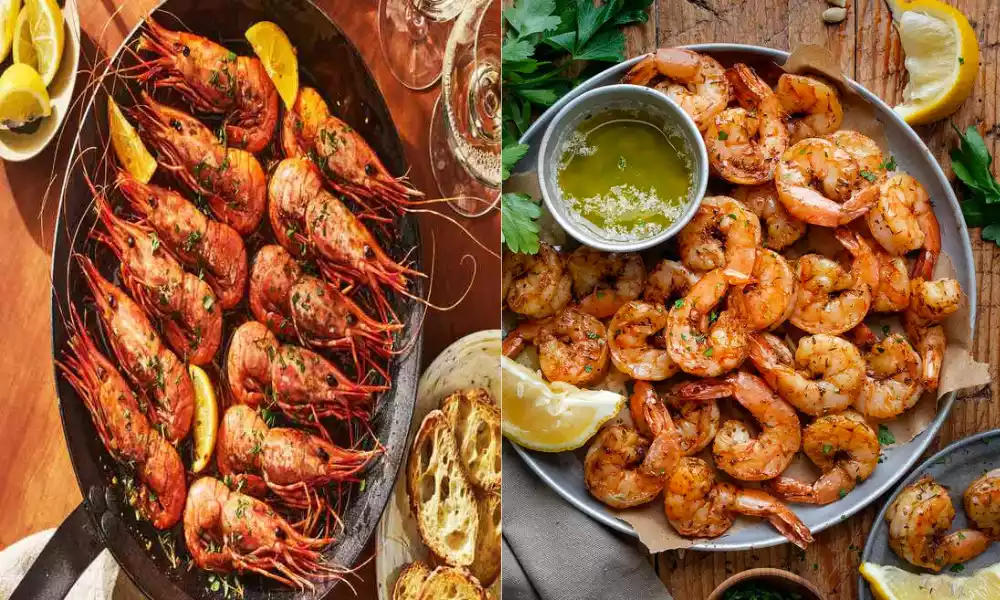Farm-raised salmon and wild salmon are two distinct types of salmon. Farm-raised salmon is bred in controlled environments, resulting in a milder flavor and softer texture. It’s available year-round but can have environmental concerns. Wild salmon, on the other hand, is caught in its natural habitat, offering a rich flavor and high omega-3 content. It’s seasonal and regulated for sustainability. Choosing between them depends on taste preference, environmental concerns, and availability. Both provide essential nutrients but come with their own set of characteristics and considerations.
Definition of Farm-raised salmon
Farm-raised salmon refers to salmon that is cultivated in controlled environments, such as aquaculture facilities, fish farms, or net pens in the ocean. These facilities are designed to raise salmon from eggs or smolts (young salmon) to market size. Farm-raised salmon are typically provided with formulated diets and controlled conditions to optimize growth and minimize disease.

This production method allows for a consistent and readily available supply of salmon throughout the year, making it a significant source of salmon for consumption. However, the practices and environmental impacts associated with farm-raised salmon can vary, and concerns about sustainability, habitat degradation, and the use of antibiotics and chemicals are often raised in relation to this industry.
Definition of Wild Salmon
Wild salmon refers to salmon that is caught in its natural habitat, primarily in rivers, streams, and oceans. These salmon are not subjected to artificial breeding or rearing in controlled environments like fish farms or aquaculture facilities. Instead, they follow their natural life cycle, which involves spawning in freshwater rivers, migrating to the ocean to grow, and returning to their natal river to reproduce.
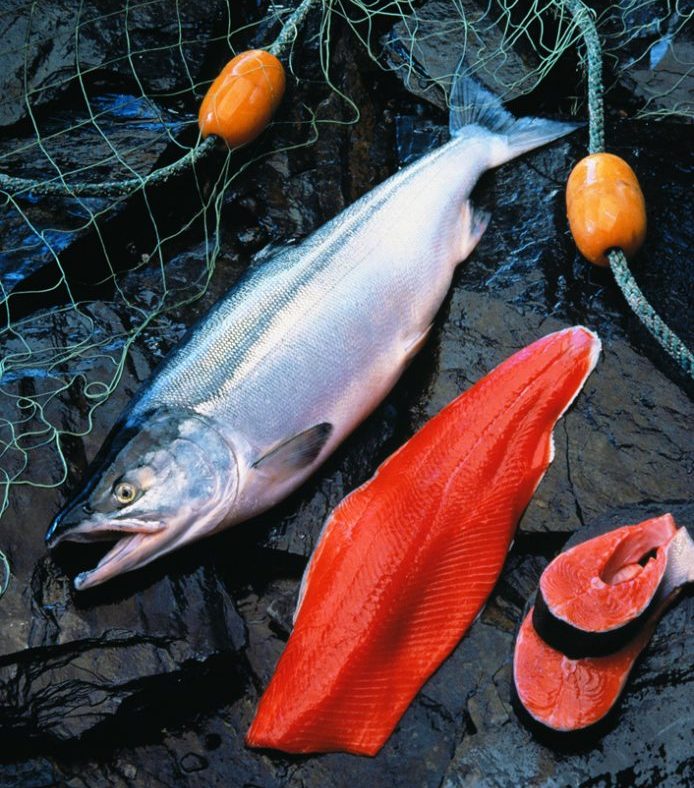
Wild salmon populations are subject to natural environmental conditions and fluctuations, and they exhibit variations in flavor, texture, and appearance depending on their species and the specific regions where they are caught. Harvesting wild salmon is typically regulated by government authorities to ensure sustainable fishing practices and the protection of salmon populations.
Wild salmon is often prized for its rich flavor, firm texture, and high nutritional value, particularly its high content of omega-3 fatty acids, such as eicosapentaenoic acid (EPA) and docosahexaenoic acid (DHA). It is regarded as a natural and traditional source of salmon for consumption, with a strong connection to the ecosystems in which it thrives.
Importance of understanding their differences
Understanding the differences between farm-raised salmon and wild salmon is essential for several reasons:
- Nutritional Awareness: Knowing the distinctions in nutritional profiles between the two types of salmon helps individuals make informed dietary choices. Wild salmon is typically higher in omega-3 fatty acids, making it a valuable source of heart-healthy nutrients, while farm-raised salmon may have a different nutrient composition due to its diet and environment.
- Taste Preferences: The flavor and texture of farm-raised and wild salmon differ, and people have varying taste preferences. Understanding these differences allows consumers to select the type of salmon that aligns with their culinary preferences.
- Environmental Impact: Awareness of the environmental implications of salmon production is crucial. Farm-raised salmon can have different environmental concerns, such as habitat degradation and pollution, compared to wild salmon. Making informed choices can support sustainable practices and reduce negative impacts.
- Health Considerations: Some individuals may have health concerns related to the use of antibiotics, chemicals, or contaminants in salmon farming. Understanding these aspects helps individuals with specific dietary restrictions or health needs make suitable choices.
- Supporting Sustainable Practices: Being informed about the differences encourages consumers to support sustainable seafood practices. It allows them to choose products from reputable sources and advocate for responsible fishing and farming methods.
- Economic Impact: Understanding the differences can also have economic implications. Wild salmon is often more expensive due to limited availability, while farm-raised salmon tends to be more affordable and accessible. This knowledge can influence budgeting and shopping decisions.
- Cultural and Ethical Considerations: For some people, the choice between farm-raised and wild salmon may be influenced by cultural or ethical factors. Understanding the origins and production methods helps individuals align their choices with their values.
Comprehending the differences between farm-raised salmon and wild salmon empowers consumers to make choices that align with their dietary preferences, health goals, environmental concerns, and ethical values. It also supports responsible consumption and sustainable practices in the seafood industry.
Comparison table of Farm-raised salmon vs Wild Salmon
Here is a comparison table highlighting the key differences between farm-raised salmon and wild salmon:
| Aspect | Farm-Raised Salmon | Wild Salmon |
| Origin | Raised in controlled environments like fish farms, net pens, or aquaculture facilities. | Caught in its natural habitat, such as rivers, streams, and oceans. |
| Production Method | Bred, hatched, and raised in captivity with controlled conditions. Fed-formulated diets. | Follows a natural life cycle, spawning in freshwater and migrating to the ocean. |
| Nutritional Profile | May have a milder flavor and softer texture. Omega-3 content varies depending on the feed. | Rich flavor, firm texture, high in omega-3 fatty acids (EPA and DHA). |
| Environmental Impact | Potential concerns like pollution, disease transfer, and habitat degradation. | Can have a lower environmental impact when caught sustainably, but overfishing can be a concern. |
| Availability | Readily available year-round. Often less expensive due to consistent production. | Seasonal availability, with specific runs during certain times of the year. Can be more expensive. |
| Health Considerations | May contain antibiotics, chemicals, or contaminants, depending on farming practices. | Generally considered a natural and traditional source of salmon with fewer health concerns. |
| Taste Preferences | Milder flavor compared to wild salmon. Texture may be softer. | Stronger, more distinctive flavor and firmer texture. Preferred by some for its taste. |
| Cultural and Ethical Factors | Some individuals have ethical concerns about farming practices. | May be chosen for cultural or ethical reasons, supporting traditional fishing methods. |
| Sustainability | Sustainability varies; some farms employ responsible practices, while others raise concerns. | Sustainable practices are essential to protect wild salmon populations. |
There can be variations within both farm-raised and wild salmon, depending on factors like farming practices, location, and species. Consumers should consider their priorities, taste preferences, and values when choosing between the two types of salmon.
Taste and Texture
Taste and texture are important factors that distinguish farm-raised salmon from wild salmon:
Taste:
- Farm-Raised Salmon: Farm-raised salmon typically has a milder and less intense flavor compared to wild salmon. The taste can be described as relatively neutral or mild, with some variations depending on the specific feed and farming conditions. Some people prefer this milder taste, as it can be versatile and appeal to a broader range of palates.
- Wild Salmon: Wild salmon is known for its stronger, more distinctive flavor. The taste can vary depending on the species and the specific environment where it was caught. Generally, wild salmon has a richer and more pronounced salmon flavor, often described as earthy, nutty, or even slightly gamey. Many seafood enthusiasts and chefs prefer the robust taste of wild salmon for its unique character.
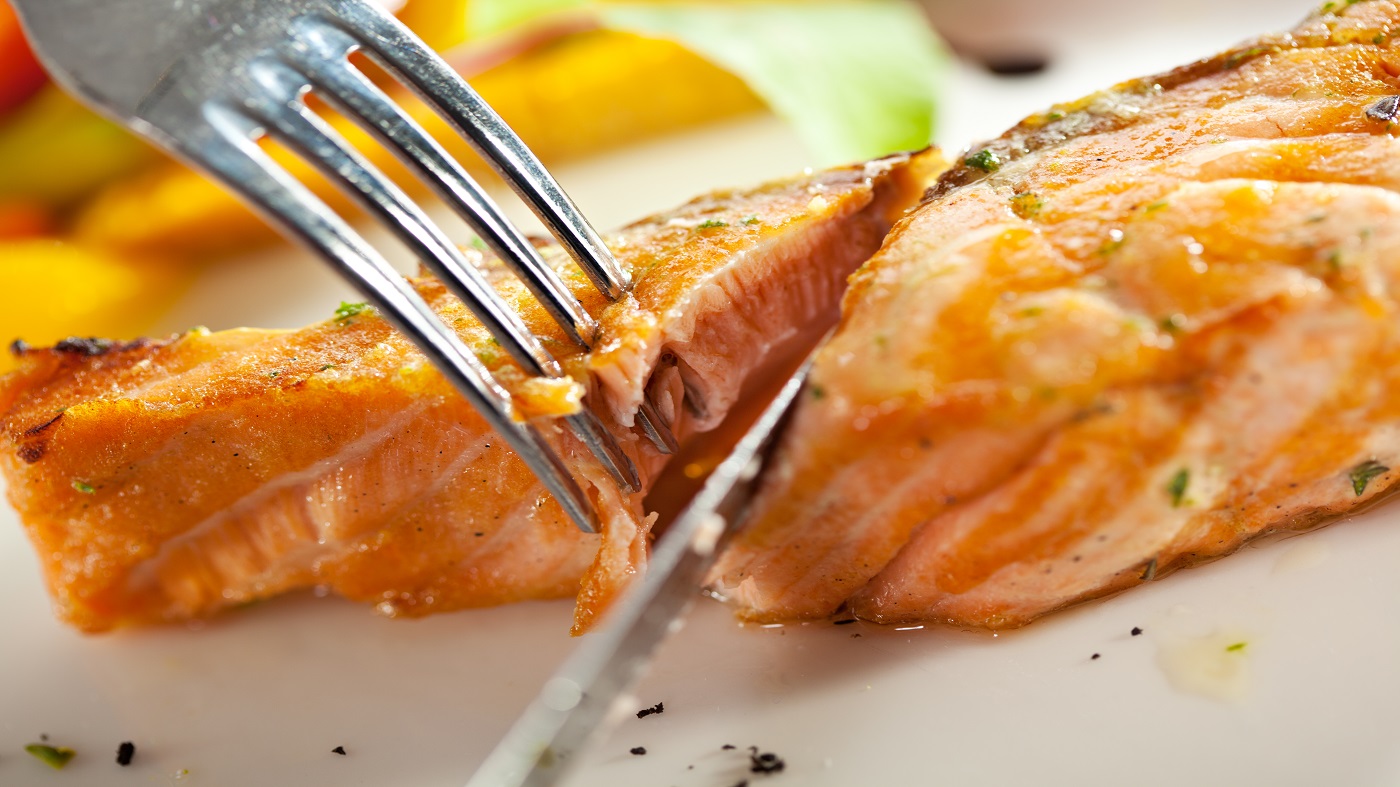
Texture:
- Farm-Raised Salmon: Farm-raised salmon tends to have a softer and more delicate texture compared to wild salmon. This is partly due to the controlled environment in which they are raised, where they have limited exercise and a consistent diet. The texture of farm-raised salmon can be described as buttery or flaky, making it easier to cut and chew.
- Wild Salmon: Wild salmon has a firmer texture. This is because wild salmon must swim and navigate strong currents in their natural environment, which leads to more developed muscle tissue. The flesh of wild salmon is often denser and meatier, with a pleasant firmness that many people appreciate. It can also have a slightly coarser grain.
Nutritional Profile
The nutritional profiles of farm-raised salmon and wild salmon can vary due to factors such as diet, environment, and farming practices.
Here’s a general comparison of their nutritional content based on typical differences:
Farm-Raised Salmon (per 3.5 ounces or 100 grams):
- Calories: Approximately 206 calories.
- Protein: About 23-25 grams, making it an excellent source of high-quality protein.
- Fat: Contains around 13-14 grams of fat.
- Omega-3 Fatty Acids: Contain omega-3 fatty acids, but the levels can vary depending on the feed. Typically, farm-raised salmon has lower omega-3 levels compared to wild salmon.
- Omega-6 Fatty Acids: Contains omega-6 fatty acids, which can vary depending on the feed.
- Vitamin D: Provides a good amount of vitamin D, which is important for bone health.
- Vitamin B12: A good source of vitamin B12, essential for nerve function and red blood cell production.
- Selenium: Contains selenium, an important antioxidant mineral.
- Astaxanthin: Farm-raised salmon may contain astaxanthin, a pigment added to their feed to give them a pinkish color.
Wild Salmon (per 3.5 ounces or 100 grams):
- Calories: Approximately 206 calories, similar to farm-raised salmon.
- Protein: About 23-25 grams, comparable to farm-raised salmon.
- Fat: Contains around 9-11 grams of fat, typically lower in fat compared to farm-raised salmon.
- Omega-3 Fatty Acids: Higher levels of omega-3 fatty acids, particularly EPA (eicosapentaenoic acid) and DHA (docosahexaenoic acid). Wild salmon is celebrated for its omega-3 content.
- Omega-6 Fatty Acids: Contains omega-6 fatty acids, but in lower amounts compared to farm-raised salmon.
- Vitamin D: Good source of vitamin D.
- Vitamin B12: Provides vitamin B12 in substantial amounts.
- Selenium: Contains selenium, similar to farm-raised salmon.
- Astaxanthin: Wild salmon gets its natural pink color from astaxanthin obtained through its diet in the wild.
Both farm-raised and wild salmon offer important nutrients, including protein, vitamins, and minerals. While farm-raised salmon can vary in its omega-3 content based on the feed, wild salmon is generally recognized for its higher levels of these beneficial fatty acids. Individuals often choose between the two types of salmon based on their specific dietary needs and nutritional priorities.
Health Considerations
Health considerations related to farm-raised salmon and wild salmon primarily revolve around factors such as nutrition, contaminants, and potential health impacts.
Here are some key health considerations for both types of salmon:
Farm-Raised Salmon:
- Nutrition: Farm-raised salmon provides essential nutrients, including high-quality protein, omega-3 fatty acids, vitamins (such as B12 and D), and minerals (such as selenium). However, the nutritional content can vary depending on the feed and farming practices.
- Omega-3 to Omega-6 Ratio: Some concerns have been raised about the omega-3 to omega-6 fatty acid ratio in farm-raised salmon. Depending on their diet, farm-raised salmon may contain higher levels of omega-6 fatty acids, which should ideally be balanced with omega-3s for optimal health. Consuming fish with an imbalanced ratio may not provide the same cardiovascular benefits as fish with a more favorable ratio.
- Contaminants: Farm-raised salmon can be exposed to contaminants such as PCBs (polychlorinated biphenyls) and dioxins, which can be present in their feed or the environment of fish farms. However, the levels of contaminants are typically regulated and monitored to ensure they meet safety standards.
- Antibiotics and Chemicals: Some fish farms use antibiotics and chemicals to control diseases and parasites in crowded conditions. There can be concerns about antibiotic residues in farm-raised salmon, although regulations and practices vary by region.
- Colorants: Farm-raised salmon may have their flesh colored with astaxanthin, a pigment added to their feed. While considered safe, some consumers may prefer salmon with a more natural color.
Wild Salmon:
- Nutrition: Wild salmon is known for its rich nutritional profile, including high levels of omega-3 fatty acids, vitamins (B12 and D), and minerals (selenium). It is often considered a healthier choice due to its natural diet and active lifestyle.
- Contaminants: Wild salmon can also be exposed to environmental contaminants, such as heavy metals (e.g., mercury) and persistent organic pollutants (POPs). However, the levels of these contaminants in wild salmon are generally lower than those found in some other seafood, and the health benefits of omega-3s often outweigh the risks.
- Sustainability: Choosing sustainably caught wild salmon supports healthy fish populations and ecosystems, contributing to long-term environmental health.
Cooking and Culinary Applications
Farm-raised salmon and wild salmon can be used in various culinary applications, and the choice between the two often depends on personal taste preferences and the desired outcome of the dish.
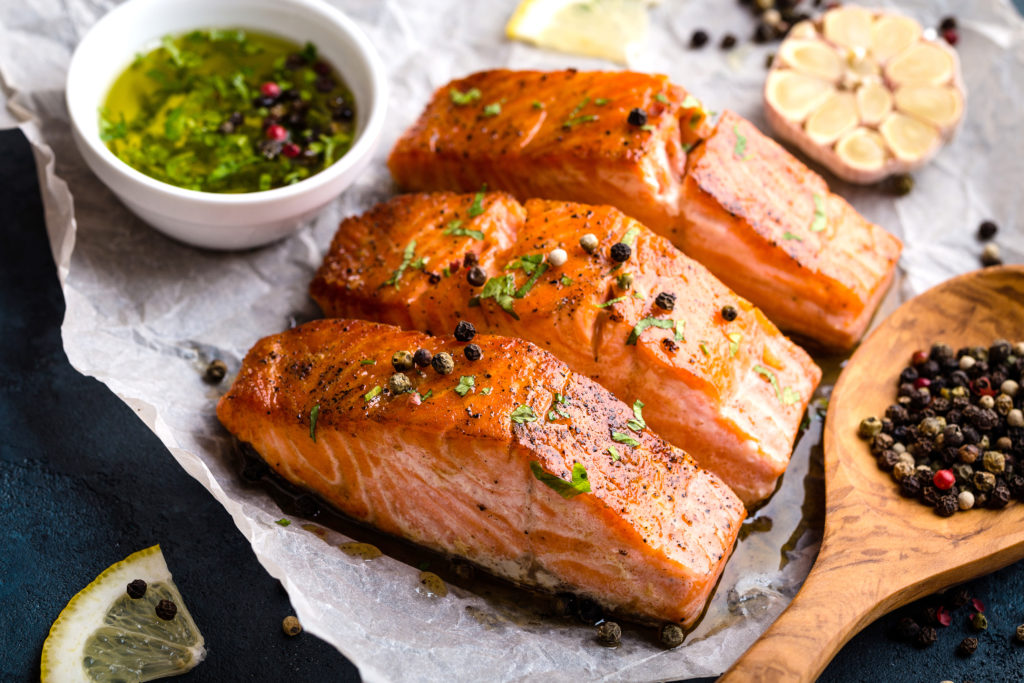
Here are some common cooking methods and culinary applications for both types of salmon:
Cooking Methods:
- Grilling: Both farm-raised and wild salmon are excellent choices for grilling. The high-fat content of salmon helps keep it moist and flavorful when grilled. Brushing with marinades or seasoning with herbs and spices can enhance the taste.
- Baking: Salmon can be baked in the oven, whether as whole fillets, steaks, or individual portions. Baking allows for the addition of various seasonings, sauces, and toppings, such as lemon, dill, garlic, or a honey-mustard glaze.
- Pan-Searing: Searing salmon in a hot skillet with a bit of oil creates a crispy outer layer while keeping the inside tender. This method works well for both farm-raised and wild salmon.
- Poaching: Poaching salmon involves gently simmering it in liquid, often with aromatic herbs and vegetables. It’s a delicate cooking method that preserves the fish’s moisture and flavor.
- Broiling: Broiling salmon under a high heat source is a quick and easy way to cook it. Farm-raised salmon’s milder flavor can pair well with strong broiler-friendly seasonings like teriyaki or BBQ sauce.
- Cedar Planking: Salmon can be cooked on a cedar plank on the grill, which imparts a unique smoky flavor to the fish. This method works well for both types of salmon.
Culinary Applications:
- Salmon Fillets: Both farm-raised and wild salmon fillets are commonly used in main courses, often served with a variety of side dishes such as vegetables, rice, or pasta.
- Sushi and Sashimi: High-quality, fresh salmon, whether farm-raised or wild, is a staple in sushi and sashimi dishes. It is often sliced thinly and served raw with soy sauce, wasabi, and pickled ginger.
- Salmon Burgers: Ground salmon, typically from farm-raised salmon, is used to make salmon burgers. They can be seasoned with herbs and spices, and served with various toppings and buns.
- Salads: Salmon can be flaked and added to salads, providing a protein-rich topping. It pairs well with greens, vegetables, and various dressings.
- Smoked Salmon: Salmon, particularly wild salmon, is often smoked and used in appetizers, sandwiches, and bagels with cream cheese.
- Casseroles and Pasta: Both types of salmon can be incorporated into casseroles, pasta dishes, and seafood chowders to add flavor and protein.
- Salmon Steaks: Salmon steaks, especially from wild salmon, can be grilled or broiled and served as a substantial main course.
The choice between farm-raised and wild salmon in culinary applications can depend on personal taste, budget, and availability. While wild salmon is prized for its distinctive flavor and nutritional profile, farm-raised salmon is often chosen for its milder taste and consistent availability. Either can be used creatively in a wide range of dishes to suit various culinary preferences.
Making the Right Choice
The best choice between farm-raised or wild salmon will depend on your desires, dietary goals, and personal values.
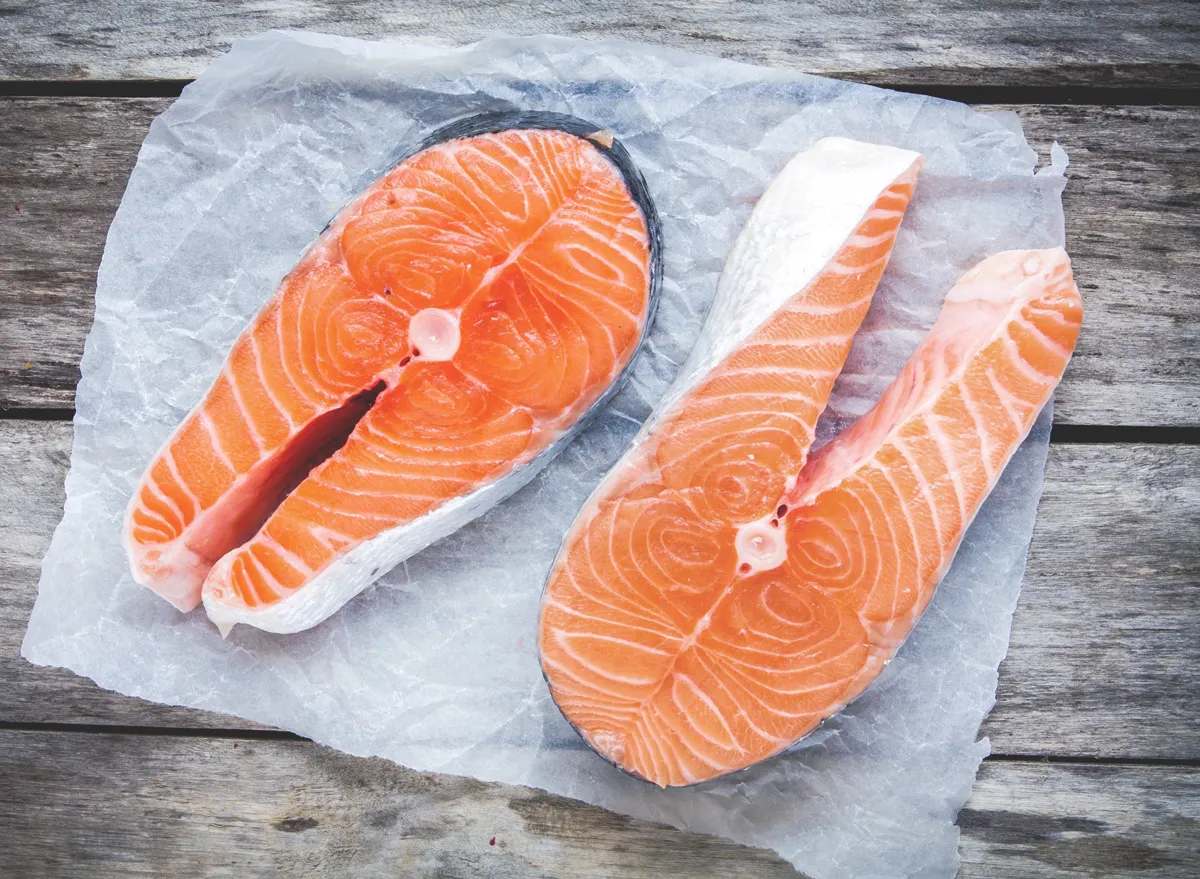
Here are some aspects to take into consideration in making your decision:
- Taste Preference: Consider your taste preferences. For those who prefer a less sour and less sour flavor, the farm-raised version of salmon might be more appealing to you. However, for those who prefer the richer, distinctive flavor of salmon wild salmon is the better option.
- Priorities in Nutrition: Take a look at your nutritional priority. If you are looking for greater levels of omega-3 fatty acids such as EPA and DHA along with other important nutrients wild salmon is renowned for its high nutritional value. The salmon that is raised on farms still provides beneficial nutrients, however, they could be lower in omega-3 depending on the diet it consumes.
- Environmental concerns: If environmental sustainability and sustainability are essential to you, look into the sources and farming methods of salmon that you select. Check for certifications like those from the Aquaculture Stewardship Council (ASC) for salmon that is raised on farms or sustainable methods of fishing in the wild for salmon.
- Health considerations: If you’re facing particular health concerns like concerns over the use of antibiotics or contaminants conduct some investigation on the fishing and farming practices for the species of salmon that you are thinking about. Find products that conform to health and safety standards.
- Accessibility and Budget: Take into account whether you can get it and what budget to use. The salmon that is raised on farms is typically more readily available throughout the year and may be cheaper than wild fish. This can be a better choice for some customers.
- Culinary Applications: Consider what you’ll use this salmon ingredient in your dishes. Both wild and farm-raised salmon are suitable for many culinary ways, however, their flavor and texture can influence your decision according to the recipe you’re making.
- Ethical and cultural factors: Be aware of any ethical or cultural considerations that could influence your decision. Certain people choose wild salmon due to traditional methods of harvesting, others might prefer farm-raised salmon due to its availability regularly.
- Certifications: Search for certificates and labels on salmon packaging to demonstrate sustainable and responsible practices, regardless of whether it is wild or farm-raised salmon. Certifications such as ASC for salmon that is farm-raised as well as MSC (Marine Stewardship Council) for wild-caught salmon help you decide with confidence on the product you choose.
Environmental Impact
The environmental impact of farm-raised salmon and wild salmon differs significantly due to their production methods and sourcing. Here’s a comparison of the environmental impacts of both types of salmon:
Farm-Raised Salmon Environmental Impact:
- Habitat and Ecosystem Disruption: Salmon farms can have a localized environmental impact. They may disrupt the natural habitats and ecosystems in coastal areas where they are situated. Waste, uneaten food, and chemicals from the farms can affect water quality and seabed conditions.
- Disease and Parasite Spread: Close confinement of fish in farm pens can increase the risk of disease outbreaks and parasite infestations. To combat these issues, antibiotics and chemicals are sometimes used, which can have negative environmental consequences.
- Escapes: Escape events from salmon farms can introduce non-native, farm-raised salmon into the wild, potentially affecting the genetics of wild populations. This can lead to competition for resources and reduced genetic diversity.
- Feed Source: The production of feed for farm-raised salmon often relies on wild-caught fish as a key ingredient. This can contribute to the overfishing of smaller species used in feed, further impacting marine ecosystems.
- Pollution: Farm-raised salmon operations can contribute to pollution through the release of waste, chemicals, and antibiotics into the surrounding waters.
Wild Salmon Environmental Impact:
- Overfishing: Unsustainable fishing practices can lead to overfishing of wild salmon populations, causing declines in their numbers. Responsible fisheries management is crucial to avoid this impact.
- Habitat Degradation: Human activities, such as logging, mining, and development, can degrade the habitats and spawning grounds of wild salmon. Pollution and dam construction can also harm these ecosystems.
- Climate Change: Climate change affects wild salmon by altering ocean conditions, water temperatures, and river flow patterns. These changes can impact salmon migration and survival.
- Bycatch: In some cases, fishing for wild salmon can result in bycatch, where non-target species are unintentionally caught. Sustainable fishing practices aim to minimize bycatch.
Sustainability Considerations:
- When choosing salmon, look for certifications and labels that indicate sustainable practices, such as the Aquaculture Stewardship Council (ASC) for farm-raised salmon or the Marine Stewardship Council (MSC) for wild-caught salmon.
- Farm-raised salmon operations that employ responsible and environmentally friendly practices can help reduce their environmental impact. Sustainable feed sources and integrated multi-trophic aquaculture (IMTA) systems are examples of such practices.
- Supporting sustainable fisheries and responsible aquaculture practices can contribute to minimizing the environmental impact of both farm-raised and wild salmon.
Similarities between Farm-raised salmon vs Wild Salmon
While wild and farm-raised salmon differ in a lot of ways, they have a few similarities:
Nutrient-rich: The farm-raised as well as the wild salmon are great sources of vital nutrients, such as protein, omega-3 fat acids (such as EPA and DHA) Vitamin D and a variety of minerals. They provide health benefits and can be a part of healthy diets.
Protein Content: The two types of salmon contain high-quality protein. They are an ideal source of this vital macronutrient for overall health and muscle wellbeing.
Multi-purpose in Cooking: A variety of farm-raised wild salmon can be substituted in a myriad of cooking and recipes. They’re versatile ingredients that are used in a variety of cuisines around the world whether baked, grilled, or poached. It can also be utilized in sushi or sushi.
Omega-3 Fatty Acids: Although there could be differences in the types of salmon used, both wild and farm-raised salmon have omega-3 fatty acids that are linked with the health of your heart, less inflammation, and improved brain function. Wild salmon is usually praised as having higher amounts of these beneficial fats.
Omega-6 Fatty Acids: The two types of salmon are also rich in omega-6 fatty acids, although the exact levels could differ. A healthy consumption of omega-3 fatty acids and omega-6 is essential for general well-being.
Varieties of Species: Both wild and farm-raised salmon are diverse species, each having a distinct flavor texture and nutritional profile. The most common species are Atlantic, Pacific, Chinook (King), Sockeye, Coho, and many others.
Cooking techniques: Wild and farm-raised salmon can be cooked using similar cooking methods and can be cooked with techniques like grilling sauteing broiling or smoking.
Accessibility: Although the availability of salmon raised on farms is more frequent and consistent all through each season, both varieties are readily available to customers in a variety of markets and different regions.
Flexible Diet: Both kinds of salmon can be incorporated into a wide range of dietary plans, including Paleo diets, Mediterranean as and low-carb diets allowing them to be adapted to different preferences in nutrition.
Health benefits: The two types of salmon, farm-raised and wild salmon provide health benefits thanks to their nutritional content, which includes the support of the brain’s health, cardiovascular health, and a lower risk of developing chronic illnesses.
The nutritional value and environmental aspects can differ between wild and farm-raised salmon, and consumers must take into consideration their personal preferences and requirements in deciding between both.
Conclusion
The choice between farm-raised and wild salmon depends on your preferences and priorities. Farm-raised salmon offers a milder flavor and softer texture, while wild salmon boasts a more distinct taste and leaner profile. Farm-raised salmon may have slightly higher omega-3 content, but wild salmon is often considered better for the environment when harvested sustainably. The decision should align with your culinary preferences, health goals, and values.


